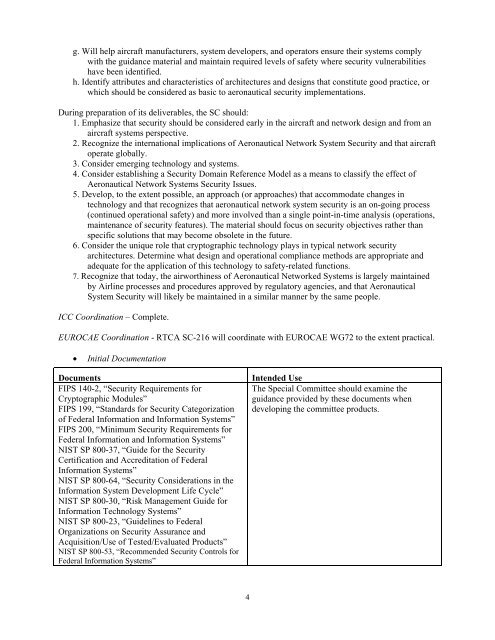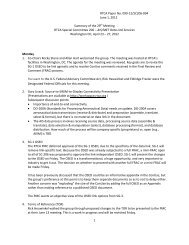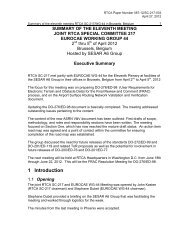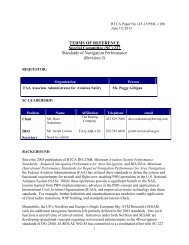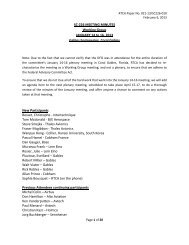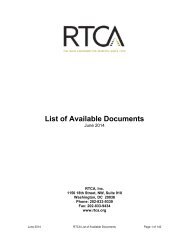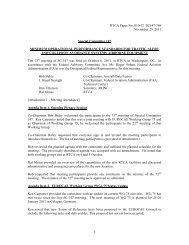RTCA Paper No. 138-12/PMC-1008 June 13, 2012 TERMS OF ...
RTCA Paper No. 138-12/PMC-1008 June 13, 2012 TERMS OF ...
RTCA Paper No. 138-12/PMC-1008 June 13, 2012 TERMS OF ...
You also want an ePaper? Increase the reach of your titles
YUMPU automatically turns print PDFs into web optimized ePapers that Google loves.
g. Will help aircraft manufacturers, system developers, and operators ensure their systems comply<br />
with the guidance material and maintain required levels of safety where security vulnerabilities<br />
have been identified.<br />
h. Identify attributes and characteristics of architectures and designs that constitute good practice, or<br />
which should be considered as basic to aeronautical security implementations.<br />
During preparation of its deliverables, the SC should:<br />
1. Emphasize that security should be considered early in the aircraft and network design and from an<br />
aircraft systems perspective.<br />
2. Recognize the international implications of Aeronautical Network System Security and that aircraft<br />
operate globally.<br />
3. Consider emerging technology and systems.<br />
4. Consider establishing a Security Domain Reference Model as a means to classify the effect of<br />
Aeronautical Network Systems Security Issues.<br />
5. Develop, to the extent possible, an approach (or approaches) that accommodate changes in<br />
technology and that recognizes that aeronautical network system security is an on-going process<br />
(continued operational safety) and more involved than a single point-in-time analysis (operations,<br />
maintenance of security features). The material should focus on security objectives rather than<br />
specific solutions that may become obsolete in the future.<br />
6. Consider the unique role that cryptographic technology plays in typical network security<br />
architectures. Determine what design and operational compliance methods are appropriate and<br />
adequate for the application of this technology to safety-related functions.<br />
7. Recognize that today, the airworthiness of Aeronautical Networked Systems is largely maintained<br />
by Airline processes and procedures approved by regulatory agencies, and that Aeronautical<br />
System Security will likely be maintained in a similar manner by the same people.<br />
ICC Coordination – Complete.<br />
EUROCAE Coordination - <strong>RTCA</strong> SC-216 will coordinate with EUROCAE WG72 to the extent practical.<br />
<br />
Initial Documentation<br />
Documents<br />
FIPS 140-2, “Security Requirements for<br />
Cryptographic Modules”<br />
FIPS 199, “Standards for Security Categorization<br />
of Federal Information and Information Systems”<br />
FIPS 200, “Minimum Security Requirements for<br />
Federal Information and Information Systems”<br />
NIST SP 800-37, “Guide for the Security<br />
Certification and Accreditation of Federal<br />
Information Systems”<br />
NIST SP 800-64, “Security Considerations in the<br />
Information System Development Life Cycle”<br />
NIST SP 800-30, “Risk Management Guide for<br />
Information Technology Systems”<br />
NIST SP 800-23, “Guidelines to Federal<br />
Organizations on Security Assurance and<br />
Acquisition/Use of Tested/Evaluated Products”<br />
NIST SP 800-53, “Recommended Security Controls for<br />
Federal Information Systems”<br />
Intended Use<br />
The Special Committee should examine the<br />
guidance provided by these documents when<br />
developing the committee products.<br />
4


